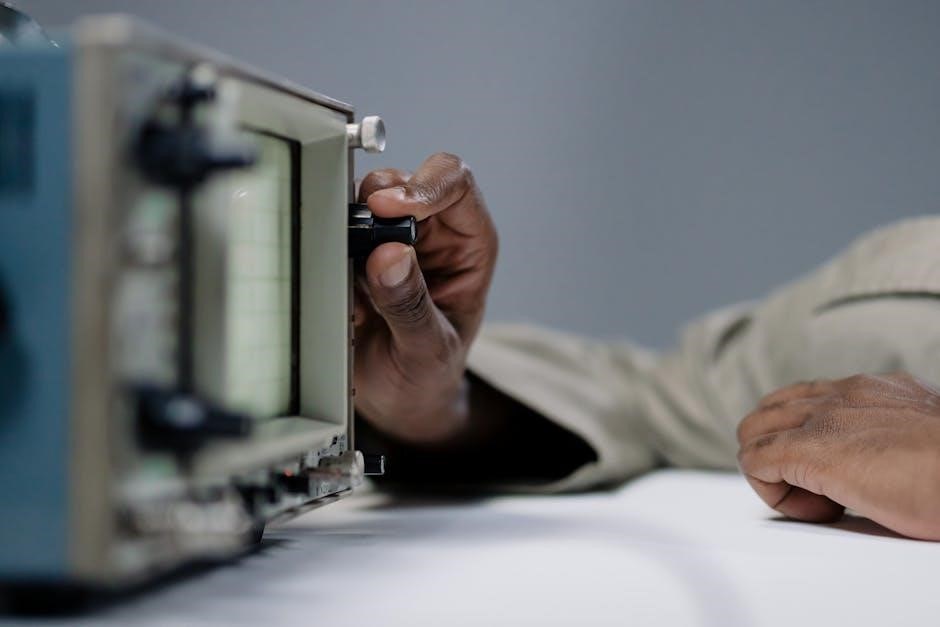A lab manual is a structured document used to record notes, observations, and procedures during practical experiments, serving as a vital tool for learning and accountability in scientific processes.

Definition of a Lab Manual
A lab manual is a structured document designed to guide experiments and record observations. It serves as a practical copy for documenting procedures, data, and results, ensuring clarity and organization. Used in classrooms, research, and professional settings, it provides detailed instructions for conducting experiments safely and effectively. The manual often includes materials, step-by-step protocols, and space for notes, making it an essential tool for learning and accountability in scientific processes;
Purpose of a Lab Manual
A lab manual serves as a guide for conducting experiments, providing clear instructions and promoting organization. It helps students learn scientific writing and prepares them for research articles. By documenting materials, procedures, and results, it ensures accountability and reproducibility. The manual also prioritizes safety, outlining protocols to follow during experiments. It fosters critical thinking and skill development, making it an essential tool for both educational and professional settings.
Structure of a Lab Manual
A lab manual typically includes sections like Materials, Procedure, Observations, Results, and Conclusion, ensuring clarity and organization in documenting experiments and findings effectively.
Materials and Equipment
The materials and equipment section lists all necessary items for the experiment, ensuring preparedness. It specifies quantities, concentrations, and sources, fostering reproducibility. Including catalogue numbers aids procurement. Descriptions of equipment detail their roles, guiding setup. Proper maintenance and calibration are emphasized for accuracy. This section may also suggest alternatives for unavailable materials, promoting adaptability. Clear organization ensures users can gather everything needed efficiently, preventing delays and ensuring smooth experimentation. Detailed descriptions enhance understanding and practical application in the lab setting.
Procedure
The procedure section outlines the step-by-step methods to conduct the experiment. It provides clear, detailed instructions, ensuring reproducibility. Each step is logically sequenced, specifying actions like measurements, equipment operation, and safety precautions. The language is precise, avoiding ambiguity. Diagrams or flowcharts may be included for clarity. This section guides users through preparation, execution, and completion of the experiment. By following the procedure, participants can achieve consistent results, minimize errors, and maintain safety standards. It serves as a roadmap for executing the experiment effectively and efficiently.
Observations and Data
The observations and data section documents all measurements, readings, and qualitative notes collected during the experiment. It requires meticulous recording of numerical values, visual observations, and any unexpected occurrences. Data is typically presented in tables, graphs, or charts for clarity. This section ensures accuracy and reproducibility, serving as the foundation for analysis. Clear and objective documentation is essential, avoiding personal interpretations. By systematically capturing data, researchers can identify patterns, trends, and anomalies, which are critical for drawing valid conclusions and refining the experimental process.
Results and Conclusion
This section summarizes the experimental findings, interpreting the collected data to determine whether the objectives were met. It presents the results clearly, often using graphs or tables, and draws logical conclusions based on the evidence. The conclusion highlights the significance of the findings, their implications, and potential areas for further investigation. It is essential to avoid introducing new data and ensure the conclusions align with the observed results. This section provides a concise overview of the experiment’s outcomes and their broader scientific relevance.
Importance of Lab Manuals
Lab manuals are essential for maintaining organization, ensuring accountability, and facilitating structured learning. They provide clear guidance, promote systematic documentation, and enhance the overall efficiency of scientific experiments and education.
Promotes Organization
Lab manuals ensure a systematic approach to experiments by organizing materials, procedures, and observations. They provide a structured format, helping users stay focused and maintain order throughout the process.
Enhances Accountability
A lab manual enhances accountability by providing a clear record of experiments, ensuring transparency and traceability. It documents every step, material, and observation, making it easier to track procedures and maintain consistency. This structured approach helps identify errors and ensures adherence to protocols, fostering responsibility and accuracy in scientific practices.

Facilitates Learning
A lab manual facilitates learning by providing clear, structured instructions and visual aids, helping students understand complex procedures and concepts. It bridges theory and practice, enabling hands-on experience and reinforcing scientific principles. The inclusion of diagrams, charts, and step-by-step guides makes it easier for learners to grasp and apply knowledge. By documenting observations and results, students can review and analyze their work, fostering a deeper understanding and improving their ability to conduct experiments independently. This iterative process enhances skill development and scientific inquiry.

How to Write a Lab Manual
Writing a lab manual involves planning before experiments, documenting procedures during, and organizing data after. Ensure clarity, include visuals, and review regularly for accuracy and completeness.
Before the Experiment
Before starting, thoroughly review the lab manual to understand objectives, materials, and procedures. Organize all necessary equipment and supplies, ensuring they are in proper working condition. Familiarize yourself with safety protocols and wear appropriate protective gear. Consult any additional references or guidelines provided. Develop a clear plan, including timelines and expected outcomes. Prepare data collection tools, such as notebooks or digital devices, to record observations accurately. Discuss any questions or concerns with instructors or peers to clarify procedures. Finalize your setup to ensure a smooth and efficient experiment.
During the Experiment
Follow the lab manual’s instructions meticulously, adhering to safety protocols and procedures. Document observations, measurements, and data accurately in real-time using notebooks or digital tools. Capture qualitative and quantitative details, including unexpected results. Avoid deviations from the procedure without guidance. Use appropriate instruments and techniques to ensure precision. Organize data clearly for future analysis. Stay focused and maintain a clean, efficient workspace. Reflect on progress and adjust as needed, ensuring thorough documentation of all steps taken during the experiment.
After the Experiment
After completing the experiment, clean and disinfect your workspace, ensuring all equipment is properly stored. Organize your data, cross-verifying measurements and observations for accuracy. Review the lab manual to ensure all steps were followed correctly. Reflect on the outcomes, noting any discrepancies or unexpected results. Store all documented findings securely for future reference. Finally, prepare for analysis by compiling data into a coherent format, ready for interpretation and reporting in the results section of your lab manual.

Best Practices for Lab Manuals
Maintain clarity and precision in instructions, include visuals for complex procedures, and regularly review updates. These practices ensure accuracy, accessibility, and effectiveness in lab manuals.
Clarity and Precision
Clarity and precision are essential in lab manuals to ensure experiments are conducted accurately. Clear instructions guide users through procedures without ambiguity, reducing errors. Use straightforward language, avoid jargon, and provide precise measurements. Visuals like diagrams can enhance understanding. Regularly review and update content to maintain accuracy. This ensures reproducibility and consistency in results, fostering a reliable and efficient lab environment. Clear communication is key to successful experimentation and safe practices.
Inclusion of Visuals
Including visuals in lab manuals enhances understanding and accuracy. Diagrams, flowcharts, and photographs provide clear, concise representations of complex procedures. Visuals help users identify equipment, understand setups, and follow steps accurately. They also make the manual more engaging and accessible. High-quality images and well-labeled illustrations ensure clarity. Visuals are particularly useful for explaining intricate techniques or safety protocols. By supplementing text with visuals, lab manuals become more effective tools for learning and experimentation, reducing confusion and improving overall efficiency in the lab environment.
Regular Reviews
Regular reviews of lab manuals ensure accuracy, clarity, and relevance. Updating procedures and guidelines keeps the manual aligned with current practices and safety standards. Reviews help identify errors, outdated information, or ambiguous instructions. They also allow for incorporating feedback from users, improving the overall quality. Regular updates ensure the manual remains a reliable resource, fostering a culture of continuous improvement. This process is essential for maintaining safety, efficiency, and effectiveness in laboratory settings, ensuring all procedures are up-to-date and properly understood by everyone involved.
A lab manual is an essential tool for guiding experiments, documenting observations, and ensuring safety. By providing clear procedures and expectations, it promotes organization and accountability while fostering learning. Regular reviews and updates keep the manual relevant and accurate. Its structured format helps users follow scientific methods and maintain consistency. Ultimately, a well-crafted lab manual supports effective experimentation, enhances understanding, and contributes to a positive lab culture, making it indispensable in educational and professional settings.